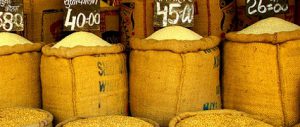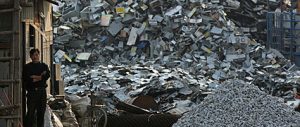In his lectures on soil pollution, Chen Tongbin always starts with four slides – a sky full of thick smog, a filthy river, piles of discarded rubbish and, finally, a shot of green rice paddies and vegetable fields.
The audience has no trouble identifying the first three as images of air pollution, water pollution and waste – but often gets stuck on the fourth. Sometimes, however, an answer is tentatively ventured: “Could it be soil pollution?”
“That’s the thing about soil pollution,” explained Chen, researcher at the Chinese Academy of Science’s Institute of Geographic sciences and Natural Resources Environmental Restoration Centre. “You can’t see it, but the soil, rice and vegetables have all been polluted with heavy metals.”
The impacts of soil pollution on the human body can take a decade or even longer to become fully apparent. And so, of the four types of pollution on Chen’s slides, soil contamination is the one that has received almost no government attention, and that the public is largely unaware of. Its effects are also the hardest to treat. The products of polluted soil, such as rice contaminated with heavy metals, harm the body in a way that is hard to detect in the short term; they are stealthy killers.
Contamination in rice is caused by soil pollution and will be impossible to fix until the government gives serious attention to the problems affecting the land. However, there is a lack of clear and reliable information on how much of China’s land is polluted by heavy metals, and how serious that pollution is.
Academics and officials commonly say that one fifth of China’s total arable land has been polluted by heavy metals. Another common claim is that 13,300 hectares have been polluted by cadmium, across 25 different areas in 11 provinces.
Chen, who has investigated these claims, said there is no firm evidence for either figure: the first is an exaggeration, while the second is too low. The conflicting figures make it clear that neither China’s academics nor its authorities have a firm handle on soil pollution.
In 2005, before a spate of heavy-metal pollution cases brought the subject crashing onto the public agenda, the Ministry of Environmental Protection (MEP) and the Ministry of Land and Resources (MLR) started a nationwide survey of heavy-metal soil pollution – the first such study at a national level.
Some researchers have pointed out that, while an accurate figure for the area affected by soil pollution in China is extremely important, it is not the only data that matters. Take rice contamination as an example: what is the pollution source? How much rice is planted on the polluted land? How serious is the pollution? How long have people been eating the rice? What levels of heavy metals have accumulated in the bodies of local people? These questions all need to be answered.
Scientists have also expressed concern that the results of the government’s survey may not be as detailed as they – or the public – would like. The country was divided up into sections of eight square kilometres each and samples taken from anywhere within those sections, and so the results may be influenced by local-government led site selection. Regardless, the central government will for the first time have a preliminary grasp of the soil pollution situation nationwide, and this will help in terms of planning and implementing a response.
Although the results of the survey were originally scheduled for publication in late 2008, they have still not emerged – apparently because the amount and complexity of work was far in excess of that expected. Nor has it been decided how much data will be released. Due to a number of considerations, only overall figures may be released, rather than details on specific locations and pollution sources.
Chinese researchers have also been working on technologies to restore polluted soil, with some early success. For example, in 1999, Chen himself – after many years of research and experimentation – discovered that a plant called centipede grass absorbs large quantities of arsenic and lead from the soil, and can therefore be used to restore heavy-metal polluted land.
Pan Genxing, head of Nanjing Agricultural University’s Institute of Resources, Ecosystem and Environment of Agriculture, and others have also attempted to reduce pollution in crops growing on contaminated land. This involves using specially formulated nutrient fluid to reduce the amount of heavy metals absorbed. Others have looked at selective breeding of rice strains in an attempt to produce a variety that can be grown safely on polluted land.
Although this research was supported by both the Ministry of Science and Technology and the Chinese Academy of Sciences, it was 2009 before Chen’s technology was used in a state-supported demonstration project of reasonable size and, to date, no local government has decided to apply the technique.
Of course, there are practical obstacles to the application of these technologies. The use of centipede grass involves significant up-front costs and farmers are unlikely to see extra income from it in the short term. The nutrient fluids may not be suitable for heavily polluted land, and new rice strains may produce disappointing yields.
The scientists are used to setbacks, but they are nonetheless concerned by the lack of interest shown by local governments in polluted areas. Some joke that they are just doing the research for their own amusement.
Over the last 10 years, Chen has often been invited by city leaders to help tackle the heavy-metal pollution issues that arise when former industrial sites are absorbed into expanding cities, and become locations for commercial and residential property.
Similarly, Pan Genxing has been working hard to promote his method of reducing heavy-metal absorption by providing crops with nutrients, but local governments are rarely interested. Yet from time to time, he finds himself the honoured guest of some city official who is hoping Pan will write a report stating that a local plot of arable land is unfit for cultivation – and can instead be appropriated for urban expansion.
Many researchers in this field argue that local governments use soil pollution as an excuse for reallocating land and have no real motive to do anything about contaminated soil and tainted rice.
Chen and Pan are most concerned about whether or not the hundreds of millions of mu of heavy-metal polluted land in China are being taken seriously and if soil restoration and crop adjustments are being approached scientifically. More often than not, they see local governments avoiding responsibility for pollution, rather than facing up to it. As a result, the problem worsens and the harm continues – and all the while, new pollution is being added.
It is unrealistic to expect a short-term fix for soil pollution and poor rice quality. But, as a start, the government needs to take the matter seriously. Only then can something be done. The constraints of China’s current system mean that leaving farmers to fix the problem on their own will not work; the government must accept responsibility.
Pan Genxing and others have argued that, with soil restoration and new rice varieties still far from effective, there are three areas in which the central government can intervene.
First, it should – at the very least – survey the health of those living in polluted areas, provide early intervention for those who need it and give a full and open account of the situation to members of the public, even those who are not affected badly.
Second, safe rice should be subsidised for farmers living in polluted areas, and efforts made to reduce their intake of contaminated rice. In fact, rice eaten in polluted areas should be entirely sourced from elsewhere.
Third, efforts should be made to restore polluted land, either by treating it while it lies fallow, or by changing the crops planted on it. For example, non-food crops such as flowers can be grown. At the least, the Chinese government should formulate an overall plan for crop-planting across polluted and non-polluted areas.
Some researchers have been pushing for tighter legislation on soil pollution, and the state is reportedly considering it. Others argue that this misses the point: China already has more than 50 laws or regulations on environmental pollution, and yet its problems remain out of control. In the United States, there are fewer such laws, but pollution has been dealt with much more successfully. The key is government determination and enforcement.
This article first appeared in Century Weekly, where Gong Jing is a reporter.
Part one: How serious is cadmium pollution?
Homepage image from Greenpeace


